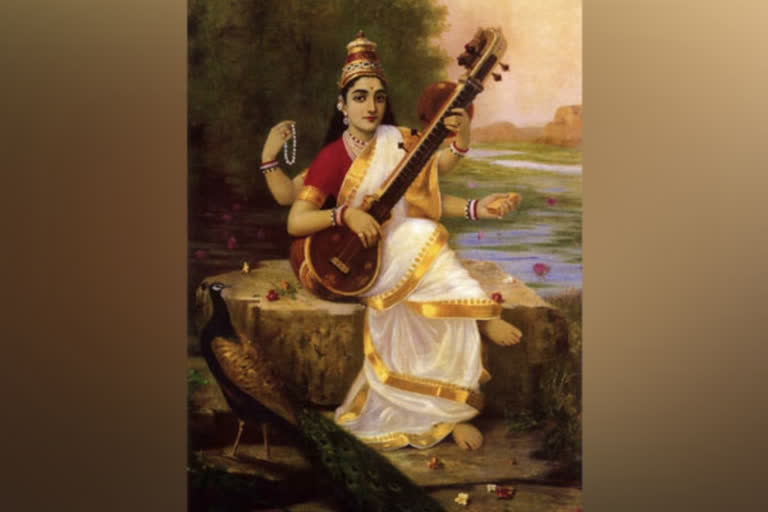Hyderabad: Basant Panchami marks the arrival of the spring season in India. Held on the fifth day (Panchami) of the Magha 'Maas' (month). Basant Panchami is also celebrated as Saraswati Puja in some parts of the country. It is believed that the goddess is worshipped on this day so that she may bestow similar gifts on her devotees.
Festivals in India are all about harmony and togetherness the fun of the occasion is simply incomplete without good food and happiness. As per Hindu Mythology, Lord Brahma is believed to have created the universe on this day. According to the Drik Panchang, in the year 2023, Basant Panchami Tithi begins at 12:34 pm on January 25th and ends at 10:28 am on 26th January. The Puja Majurat Starts 12:34 on January 25th.
Also, the reason for the celebration of Saraswati Puja in some parts of the country is because it was believed that on this day Goddess Durga gave birth to Goddess Saraswati. The significance of the occasion is huge in Hindu culture, as the day is considered extremely auspicious to start new work, get married or perform house warming ceremony (Grah Pravesh).
Basant Panchami is predominantly, celebrated in eastern parts of India as Saraswati Puja, particularly in West Bengal, Bihar and north-eastern states like Tripura and Assam. The goddess, Saraswati is dressed in yellow, and flowers, and sweets of the same colour are offered to her. People visit her temples and worship her.
The colour yellow holds great importance in the celebration of Basant Panchami. It marks the harvest time of the mustard crop that has yellow blooms, which is Goddess Saraswati's favourite colour. Hence, yellow attire is worn by the followers of Saraswati. Moreover, a traditional feast is prepared for the festival wherein the dishes usually are yellow and saffron.
In North India, especially in Punjab and Haryana, Basant Panchami is celebrated as a festival of kites. Sweet rice is one such mouthwatering dish served in Punjab. Other dishes include Makki ki Roti and Sarso ka Saag. The sight of wide patches of fields filled with mustard crops is another characteristic of this season. In Rajasthan wearing jasmine garland to celebrate this festival is a part of the rituals.
In the southern states of India, the festival is celebrated as Sri Panchami. Yagnas are done in schools and colleges as students celebrate with great sincerity and fervour. It is believed that Goddess Saraswati bestows her devotees with lots of wisdom, learning and knowledge, as the goddess is considered to be the epitome of wisdom. Students and teachers wear new clothes, offer prayers to the goddess of knowledge and various programs of song and dance are organised to please her. Usually, toddlers start learning from this day in a unique ceremony named 'Khadi-Chuan'/Vidya-Arambha.
Interestingly, there are quite a few myths associated with the festival:
According to popular beliefs, the goddess of knowledge, art, music and science, Saraswati was born on this day and people worship her to achieve wisdom. Popular folklore goes that poet Kalidasa, before attaining knowledge was a simpleton who was tricked into marrying a princess who did not respect him. A dejected Kalidasa tried to commit suicide but the goddess Saraswati appeared before him and asked him to take a dip in the river. On doing what he had been asked to do, he emerged from the water an intelligent, knowledgeable and cultured person, who would eventually become a renowned poet.
Another story related to Kamadeva goes that after the god of love was turned to ashes by Lord Shiva for his misdeeds, his wife Rati went through an arduous 40 days of penance to bring her husband back. On the day of Basant Panchami, Shiva finally relented and brought Kamdeva back to life. This is why Kamadeva, the god of love and desire, is worshipped along with his wife Rati on this day.
Another historically placed legend is that the observation of the festival started with the arrival of the Aryans. It is believed that the Aryans travelled through Khyber Pass and crossed the Saraswati River to reach India. When they settled in, the Saraswati River became an important source of life for them, so the celebration became routine.
Muslims too have been celebrating Basant since the 12th century AD. Legends say that after Delhi's Chishti Saint Nizamuddin Aulia's young nephew Taqiuddin Nooh died, he was so stricken with grief that he withdrew from society. The court poet Amir Khusrau tried thinking of ways to brighten the Saint’s mood. Upon seeing local women carrying flowers on Basant and dressed in yellow, Khusrau too dressed in yellow and took flowers to the Saint. This brought a smile to the Saint's face. Since then, Basant has been celebrated at the Dargah of Nizamuddin Aulia in Delhi and all Dargah's of the Chishti order.
The festival is celebrated by people in various ways depending upon their region in the Indian subcontinent. Basant Panchami also marks the start of preparation for Holi, which takes place forty days later.
